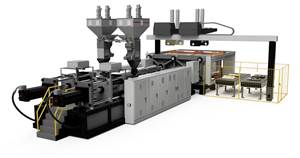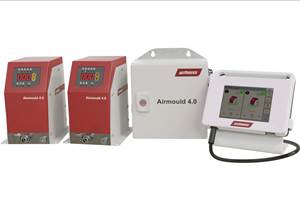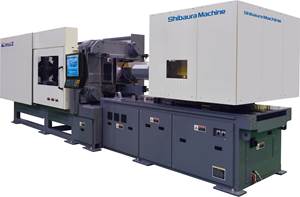New Approaches for Large Parts Highlight Structural Plastics Show
Molding large parts was the focus at the SPI’s annual Structural Plastics Conference and Exhibition held this spring in Nashville, Tenn.
Molding large parts was the focus at the SPI’s annual Structural Plastics Conference and Exhibition held this spring in Nashville, Tenn. Some of the innovations discussed there were new ways to injection mold structural thermoplastic long-fiber composites and optically clear canopies for fighter aircraft. The meeting also explored the benefits of combining three pro cesses (overmolding, insert molding, and gas assist) as a route to parts consolidation and eliminating secondary operations.
Long-fiber composites
The latest addition to the fast-growing field of direct-compounded long-fiber thermoplastics is designed for cost-effective production of large structural parts. ThermoPlastic FlowForming (TPF) is a new extrusion/compression process from Thermoplastic Composite Designs Inc., a molder in Mims, Fla. TPF can create variable-thickness parts up to 20 to 30 sq ft with reinforcing fibers up to 3 in. long or longer. Company president Dale Polk says it can handle a wide range of materials, from commodity to engineering grades and virgin or recycled polymers. TPF can introduce organic fibers, glass, or carbon fibers into the composite. And it can operate at rates from 600 to 3000 lb/hr.
The proprietary method compounds bulk materials, adds the reinforcing fibers, then delivers the compound into the tool under low pressure and virtually stress-free. At the heart of the process is a computer-controlled, in-line blending system utilizing a proprietary extruder screw and barrel to mix the ingredients, eliminating the need to pre-compound the materials. It blends virgin or recycled resins along with measured quantities of any long-strand fiber, colorants, and additives. Then it extrudes the melt into an open compression mold at a precise flow rate, volume, and thickness with minimal breakage of the long fibers. “The system can retain up to 90% of the fiber length,” says Polk. His firm has molded parts with up to 70% reinforcement.
TPF can be used with more than one mold at the same time, which can raise production rates while trimming labor and the number of machines required. The low-pressure nature of the molding step leads to stress-free parts, lighter tools, and less wear on the mold and machine.
The TPF process is available for licensing, adds Polk, whose company developed the method in the mid-1990s. So far the company has issued two licenses. One is to Envirokare Tech Inc. in Orlando, Fla., which makes a shipping pallet using recycled PP copolymer and 1-in. chopped glass. The pallet reportedly demonstrates at least 3500-lb racking strength and excellent impact resistance at low temperatures.
Polk’s company is using TPF in applications for the U.S. Defense Dept., one being a 20 x 8 x 8 ft container for the Air Force. Licensing of TPF technology for general applications is through Envirokare.
Multi-process success
A combination of overmolding, insert molding, and gas assist helped Accurate Molded Plastics Inc. in Coeur d’Alene, Idaho, produce a portable defibrillator that consolidated 59 parts into five and eliminated expensive secondary operations, says Randy Russell, sales engineer. The part, which garnered the conference’s Medical & Scientific Product Award and one of the three People’s Choice Awards, incorporates 14 overmolded features and five inserts.
The defibrillator has a substrate of FR-110 PC/ABS from Bayer Corp. overmolded with an EstaGrip TPU from Noveon Inc., selected for physical properties and for bonding compatibility. The first shot provided ribs and thickened sections in precise areas as a precaution to prevent the second shot from warping the overall assembly, says Russell.
A single gas pin was used to reduce sink marks on the cosmetic side opposite to the center boss. Gas assist also helped to lower the packing pressure, shorten cycle time, and reduce visible “shadowing” of the black second-shot runner through the yellow PC/ABS. The gas further helped reduce part weight by 4.8 g.
Clearly a big shot
A special bulk injection molding process from Envirotech Molded Products Inc. in Salt Lake City was used to injection mold a 78-lb, 1.25-in.-thick, clear aircraft canopy in one piece. The polycarbonate canopy, which grabbed the show’s Conference Award as well as the Industrial Military Award, was designed to replace hand-formed canopies of laminated acrylic sheets, produced in a drape-forming process that is much more time-consuming and expensive. The drape-forming process typically takes weeks and can cost $20,000 to $40,000 apiece, compared with 3 to 4 hr of production and a cost of a few thousand dollars with the bulk molding process, says Bob Stone, product marketing manager at Envirotech. In addition, variations in part thickness make the current drape-formed canopies difficult to polish, resulting in scrap rates of 20% to 30%. “All of the aircraft canopies designed for U.S. fighter jets today are made with the drape-forming process, so the value of this new alternative is great,” adds Stone.
Envirotech’s proprietary process was developed back in the 1960s. It uses conventional injection molding equipment that has been modified to deliver very large amounts of material. The process has been used to produce parts weighing up to 500 lb and 5 in. thick.
The bulk molding process is not yet approved for aircraft canopies. However, the U.S. Air Force may give it the nod later this year to make replacement canopies for 500 46-lb canopies for the T-38 type trainer jets, as well as canopies for the new F/A-22 jet.
Related Content
Structural Foam Injection Molding Line Extended
At K 2022, Wilmington Machinery introduced the dual-injection Lumina MP1200 medium pressure molding machine.
Read MoreInternal Gas Pressure Molding Offers Sustainability Benefits
Wittmann Battenfeld says its upgraded Airmould 4.0 technology, which features a more compact footprint, saves material and cycle time — thereby also cutting energy use.
Read MoreCompletely Connected Molding
NPE2024: Medical, inmold labeling, core-back molding and Industry 4.0 technologies on display at Shibaura’s booth.
Read MoreFakuma 2023: Wittmann Battenfeld Expands All-Electric Line, Direct-Current Capabilities
Wittmann Battenfeld will introduce the new EcoPower B8X injection molding machine line and show direct current as an energy source for a concept machine that will power its own robot.
Read MoreRead Next
Troubleshooting Screw and Barrel Wear in Extrusion
Extruder screws and barrels will wear over time. If you are seeing a reduction in specific rate and higher discharge temperatures, wear is the likely culprit.
Read MoreAdvanced Recycling: Beyond Pyrolysis
Consumer-product brand owners increasingly see advanced chemical recycling as a necessary complement to mechanical recycling if they are to meet ambitious goals for a circular economy in the next decade. Dozens of technology providers are developing new technologies to overcome the limitations of existing pyrolysis methods and to commercialize various alternative approaches to chemical recycling of plastics.
Read MoreUnderstanding Melting in Single-Screw Extruders
You can better visualize the melting process by “flipping” the observation point so that the barrel appears to be turning clockwise around a stationary screw.
Read More



























